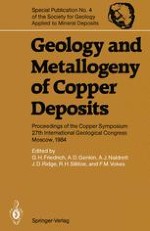1986 | OriginalPaper | Buchkapitel
Controls on the Formation of Komatiite-Associated Nickel-Copper Sulfide Deposits
verfasst von : C. M. Lesher, D. I. Groves
Erschienen in: Geology and Metallogeny of Copper Deposits
Verlag: Springer Berlin Heidelberg
Enthalten in: Professional Book Archive
Aktivieren Sie unsere intelligente Suche, um passende Fachinhalte oder Patente zu finden.
Wählen Sie Textabschnitte aus um mit Künstlicher Intelligenz passenden Patente zu finden. powered by
Markieren Sie Textabschnitte, um KI-gestützt weitere passende Inhalte zu finden. powered by
Nickel-copper sulfide deposits associated with rocks of komatiitic affinity may be divided into two associations on the basis of host rock composition and ore distribution: (1) stratiform, massive-matrix-disseminated sulfides hosted by cumulate komatiite lava flows (lava conduits), or strata-bound, coarse disseminated sulfides hosted by cumulate komatiite bodies near volcanic vents, and (2) strata-bound, finely disseminated sulfides and more restricted massive sulfides hosted by subvolcanic komatiitic dunites (high-level magma chambers). These deposits represent a continuum in environments of emplacement from distal volcanic through proximal and central volcanic to subvolcanic.Field relationships and geochemical data suggest that the sulfides in these deposits are magmatic in origin. Previous models for their formation involve derivation of sulfides directly from the mantle or from low-level magma chambers, but there are several field, physical, and thermodynamic constraints which suggest that this may not be feasible: (1) the spatial concentration of mineralization within certain pans of otherwise virtually barren host units suggests that the latter were not uniformly saturated in sulfide at the time of emplacement; (2) there are physical problems in transporting dense sulfides in low viscosity komatiite magmas, although dispersed sulfide droplets may be supported during rapid ascent; and (3) high temperature komatiitic melts generated by high-degree partial melting, or sequential melting, of mantle source rocks are unlikely to be sulfide-saturated in the source region or to remain sulfide-saturated during adiabatic ascent. These deposits are, however, commonly associated with specific country rocks, particularly sulfidic sediments, and the distribution of the ores appears to be related to the distribution of these rocks. It is most likely that the sulfide ores exsolved from the komatiitic magmas in situ, in response to assimilation of the country rocks during emplacement. The distribution and texture of the mineralization was probably influenced by (1) the mode of emplacement (volcanic vs subvolcanic) and amount of assimilation; (2) the relative volume of magma (lava conduit vs magma chamber) and its capacity to dissolve sulfur; and (3) the timing of sulfide separation and opportunity for segregation.A fundamental aspect of this model is the coincidence of cumulate komatiitic host units (representing dynamic lava conduits and magma chambers) and siliceous, sulfidic, or ferric iron oxide-rich sediments, the former representing a source of heat for assimilation and of ore metals, and the latter a source of sulfur or of components to induce sulfide separation. Mineralized greenstones appear to have formed in deeper water under conditions of greater extension than unmineralized greenstones; rifting environments represent the most favorable tectonic environment for voluminous komatiite eruption/irruption and for accumulation of sulfidic sediments. Variations in the degree of extension along or within the rift may influence the mode of komatiite emplacement and therefore the type of deposit.
